- Blog
- The Future of Text Message Marketing: Best Practices & Predictions
The Future of Text Message Marketing: Best Practices & Predictions
-
Nikolett Lorincz
- Marketing
- 6 min read
Table of Contents
Over the past couple of years, it’s become increasingly clear that text messages are the marketing tool of the future.
It’s the fastest, most efficient way to interact with your shoppers. And that’s true whether we’re talking about potential customers or your most loyal existing customers.
At OptiMonk, we’re always looking for ways to help the ecommerce community get the most out of their marketing spend.
That’s why we reached out to 7 of the leading text message marketing experts and asked for their predictions, their tips for getting started with text message marketing, and their suggestions for how to boost your results and get more SMS subscribers.
Ready to learn from the pros? Grab a cup of coffee and let’s dive in!
Top 3 text marketing predictions for 2025
Ecommerce is constantly evolving and adapting to changing consumer habits and preferences. The move toward SMS marketing is already shaking things up, but we wanted to hear from the experts about exactly what we can expect this year.
1. SMS will become a primary communication channel
The most unanimous prediction from our 7 experts was that SMS/text message marketing will become a primary communication channel for ecommerce businesses in 2025.
Even a few years ago, research was already indicating that SMS messaging would become an increasingly important marketing channel.
A survey found that 66% of consumers preferred to use text messages to communicate with businesses and 85% of consumers said that they would actually reply to text messages.
Today, the brands that have started using SMS marketing are seeing outstanding results: on average, SMS messages have a 98% open rate and a 19% click-through rate.
And still, many businesses either don’t use text messages at all or don’t use them to their full potential.
“Text message marketing is still an underdog, as many brands haven’t embraced this channel yet,” says Bernard Meyer, Director of Content at Omnisend. “That’s about to change, as more customers not only are getting used to it, but are expecting brands to communicate with them quickly and immediately after they perform certain actions.”
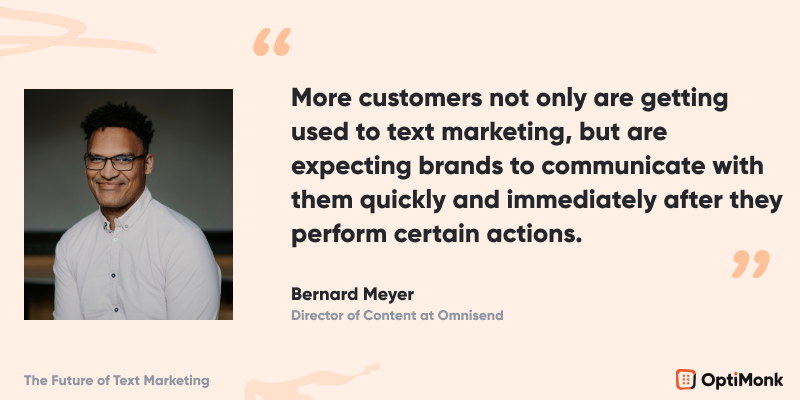
The ongoing privacy changes are also contributing to the rise of text message marketing, according to Viktoria Philbrick, Content & Partnerships at SMSBump:
“Entirely zero-party-data-based, text message marketing is what will help ecommerce brands deal successfully with the new realities, which is why more and more online stores are looking to turn SMS into a primary communication channel.”
Soma Toth, CEO of Recart, agrees with Viktoria:
“Most brands are still highly reliant on the price and targeting of Facebook and Instagram ads. Due to the rising costs and less effective targeting, these brands are being forced to use other channels like email and SMS.”
Jason K Williamson, founder of E2 Agency, has been an email & SMS marketer for years.
Based on his experience, he says that “the way that people engage with their phones, shop on their phones & receive texts on their phones, eventually SMS marketing will be the premium way to reach customers directly to their devices with ridiculous open rates, insane click-throughs, and jaw-busting sales. It’s the future without a doubt.”
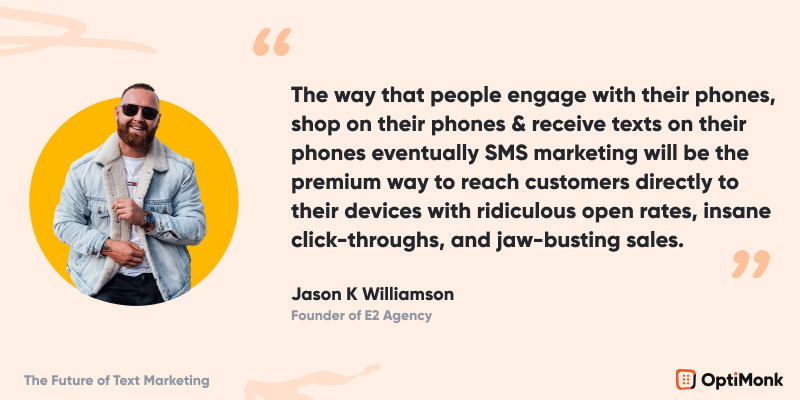
Vineet Gupta, Digital Marketing Manager at 5MinutesSEO, believes that AI-based chatbots are also going to play a huge part in the future of text message marketing:
“Businesses can set advanced trigger-based marketing messages to build upon their marketing efforts and to offer a guided customer experience throughout the customer journey. Celebrating milestones, onboarding new customers, addressing cart abandonment, and collecting customer feedback—SMS is more well-received by customers as compared to emails.”
2. SMS messages will feature more personalized, “human” interactions
Customers like receiving text messages because they’re immediate, concise, and often have personality.
But these benefits disappear if it’s obvious the text message is from an automated bot.
Lisa Popovici, Founder of Cartloop, says that “we need to walk the line saying marketing automation is bad because it’s not. It has its time and place, whether it’s a sale announcement or product update. At the same time, text is a very sensitive channel that should be used more for a 1:1 approach.”
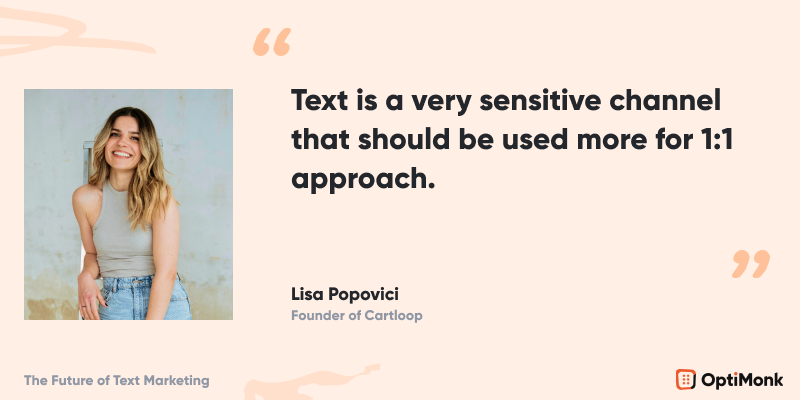
“Communicating with customers is harder than ever,” Popovici continues, “We have to bring humans back to ecommerce. So moving forward, brands have to ask themselves what they can do to make it easy for shoppers to become customers. And I believe it’s about becoming more human and bringing back what ecommerce basically is—a relationship, a transaction between a client and a product.”
This trend toward more personalization can be seen in other marketing channels as well.
Alexa Lemzy, Marketing and Communications Manager at TextMagic, says this means businesses need to offer “better recommendations and predictions of each customer’s needs. As a result, it is increasingly important for businesses to fully integrate text marketing into their CRM systems to make full use of customer data to provide more individualized service.
The next stage of this evolution is the development of all-inclusive customer management platforms (such as Touchpoint ) with all communication channels under a single roof, rather than the current approach of combining many different tools and apps to cover every channel.”
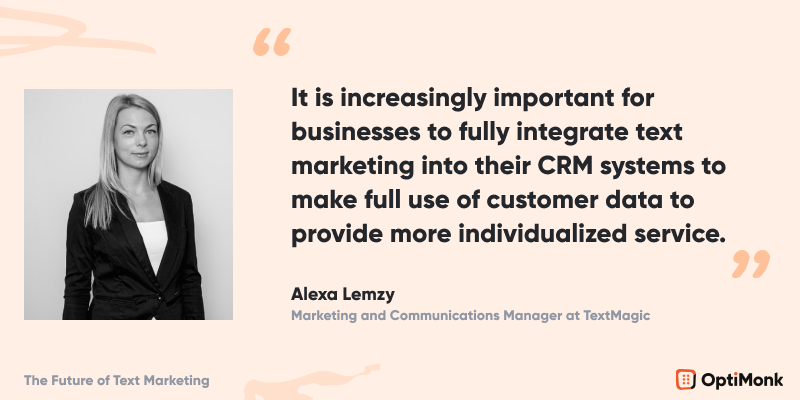
3. Text-to-buy will enter the ecommerce landscape
Text-to-buy is a revolutionary approach that contributes significantly to SMS marketing success by allowing products to be sold through text messages without relying on external links or a traditional ecommerce checkout process.
Instead, buyers simply send a text outlining what they want to buy, and the ecommerce store places and fulfills the order using stored shipping and billing information.
“We’re not too far away from a future where ecommerce is entirely conversation-based, with SMS taking the lead in making this happen,” says Viktoria Philbrick, Content & Partnerships at SMSBump.
“As brands are looking for ways to shorten the buyer’s journey and distance to purchase, the so-called ‘text-to-buy’ will be the quick solution we’re all looking for—both from a brand and consumer perspective. Providing this frictionless experience will significantly increase conversion rates as it will make shopping from a mobile device a hundred times faster and more convenient.”

4 proven marketing strategies to kickstart your SMS marketing
Now that you’ve seen how quickly SMS marketing is becoming an integral part of ecommerce, you might be wondering how to get on board with effective sms strategies.
Here’s some expert advice about getting your SMS marketing off the ground.
1. Build a strategy
If you want to get the most out of text messaging, you need to start by incorporating SMS marketing into your strategy, taking the diversity of your shoppers into account: no one text message will be appropriate for all your customers.
Lisa Popovici says you shouldn’t “pursue your leads at face value. Dig deeper. Find out who they are and then give them the unexpected. Your first step is to uncover their needs. Every marketer, for better or for worse, has to discover the “pain” of an audience. Simply uncover their biggest challenges, and then present your product as their solution.”
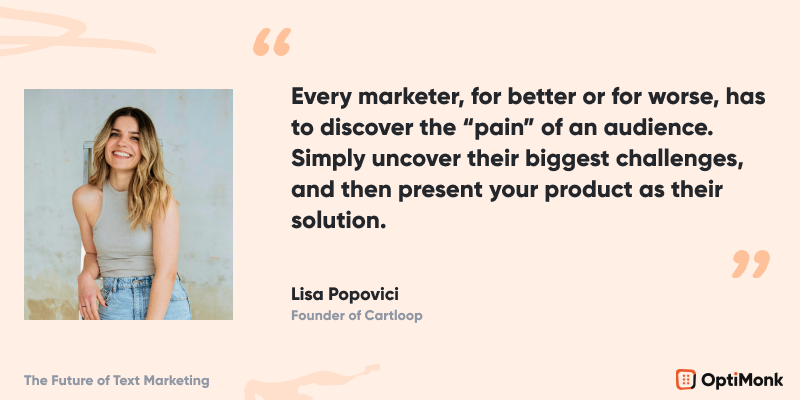
Lisa also shared 4 actionable next steps to help you get started:
- Start a conversation with shoppers who abandon their carts within 30 minutes.
- Engage in proactive support (and automate your reactive support).
- Acknowledge your customers’ concerns and address them wisely.
- Reply to inquiries within 5 minutes—whether they arrive through SMS or live chat.
2. Be compliant
You need to make sure you’re complying with all the relevant privacy regulations and GDPR when collecting phone numbers and sending marketing text messages.
The most important principle is that you must receive written consent before texting consumers any promotional messages.
Depending on the market you’re in, failing to obtain authorization from your customers could cost you between $500 and $1,500 per text in fines.
That’s why it’s no surprise that Viktoria Philbrick thinks it’s critical to respect your customers’ privacy:
“Getting your customers’ phone numbers and ensuring you are compliant is the very first step of your SMS marketing strategy,” she says.
Vineet Gupta agrees.
His first piece of advice for getting started is “to proceed only after you have obtained all the legal rights to communicate with your customers via text. There are a number of government regulations that you must adhere to.”
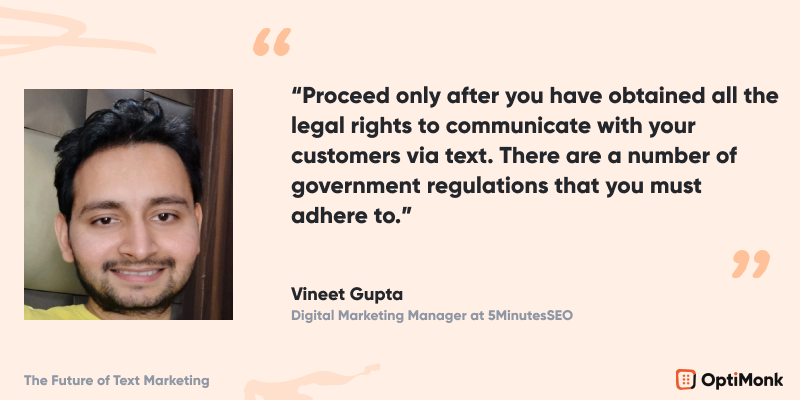
3. Build a list of subscribers and turn them into customers
Once you have a strategy in place and ensured that you’re complying with regulations, it’s time to focus on your SMS marketing efforts by building your list.
Viktoria from SMSBump says this is what “can make a difference for your brand. Because remember—the more SMS subscribers you have, the more sales you’ll be able to make.”
Jason K Williamson has some great practical advice about this stage of the process.
“I’d create a popup that captures unengaged visitors and then I’d use a text message sequence to give them an offer. Multiple messages that touch pain points (such as poor shipping times or bad customer service) and can help you put their fears at ease with on-brand messages,” he says.
You can actually “steal” the exact list-building strategy Jason is using to unlock thousands of hidden sales in their clients’ ecommerce stores.
Just watch his free training on YouTube. Or you can watch the first lesson here:
Soma Toth agrees that collecting lots of subscribers is a crucial step in SMS marketing.
He suggests using the 10% rule to evaluate your progress:
“If you’re not subscribing 10% of all your website visitors into your SMS list, you’re behind. Don’t forget: you can only generate revenue from SMS if you have people to message. Get a full-size popup, put a great offer on it: your revenue automated messages and campaigns will instantly boost.”
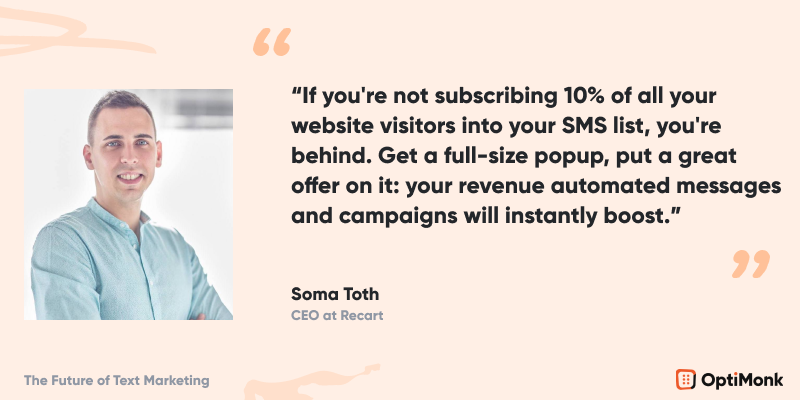
4. Optimize your marketing messages
Once you have a list of subscribers, you need to make sure that you’re sending the right type of marketing text messages.
First, it’s important that you don’t write text messages like you would write an email marketing campaign.
Bernard Meyer confirms, “text marketing is short form, direct, and immediate, and so you need to make sure you adapt your message to that format. Beyond that, always try to test different messaging times, styles, and purposes, to see which works best via text or email.”
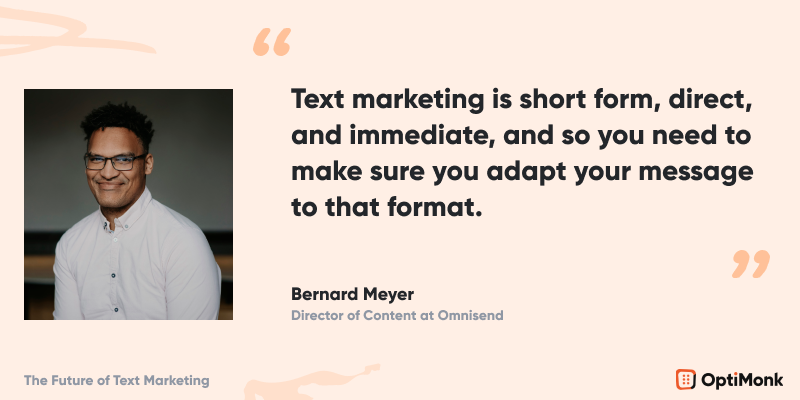
Alexa Lemzy’s top piece of advice is to “focus on using text marketing to benefit your customers. Besides the more obvious uses like promoting events and sales with a discount or coupon, text marketing can make your business more convenient to use by providing order updates, appointment reminders, additional business information and alerts, and much more.”
Vineet Gupta also shared some pointers to keep in mind:
- Focus on delivering value instead of bombarding customers with messages.
- Send text messages at appropriate times (not too early in the morning or too late at night).
- Offer customers an easy way of unsubscribing from the list.
Top 4 tips to boost your SMS/text message marketing results
These next four tips are for brands that are already using SMS messaging but looking for ways to improve their results.
Check out these expert suggestions.
1. Go beyond transactional texts and automation
Popovici suggests treating text messaging as a collaborative tool for two-way communication, not just for transactional texts that are sent automatically.
“Use it as a channel to get insights from customers, whether it’s product feedback, fulfillment, and logistics feedback, or just starting a conversation about what they’d like to see coming out of your brand,” she says.
2. Personalize messages
We’ve already talked about how text-based communication is going to get much more personalized in 2025. Our experts shared a few tips on how to accomplish that for your own brand.
“If you’re already active on SMS, I have a tip for you to increase campaign revenues by 24%: follow-ups,” suggests Soma.
He continues, “Laser-targeted follow-up messages sent to people who engaged with a campaign but didn’t purchase works for Recart clients perfectly. We ultimately see follow-ups engaging 1.7% of total recipients to drive 24% of the total campaign revenue. You can read how to replicate the strategy here.”
Lemzy says that “keeping track of key customer information in your CRM, such as purchase history, browsing history, and demographic data, and using it in your text marketing campaigns, lets you send more relevant messages to each customer.”
And here’s Phillbrick’s tip: “Think of it this way – would you give something as personal as your phone number to a brand that you’re not all that fond of? Knowing this, brands need to ensure that every bit of information they send to their customers will truly be relevant to them, which in turn will maximize customer loyalty, engagement, and of course sales.”
3. Make your offer enticing
Jason says you should “strike when the iron is hot and make your offer as juicy as humanly possible. SMS has 98% open rates and on keyword replies, I’ve seen click-through rates as high as 80%…. (NO JOKE.) This means you should be throwing everything at them to give them your phone number, the moment they do, give them an offer so good they simply cannot refuse.”
4. Analyze your results
Every SMS marketing campaign will perform differently, even when all of them are for the same brand.
That’s why Vineet thinks it’s “important to track, monitor, and compare the results for every single campaign. This one step is extremely crucial for making sure that your marketing campaigns stay relevant and well-targeted. When you compare the results of every campaign, you gradually learn what makes your customers happy and which messages generated the highest number of clicks.”
Looking at trends in your marketing data will help you answer other important questions, like:
- Have you missed any customer segments?
- Have you chosen the right segmentation criteria?
- What percent of your new customers click through to take advantage of your discounts?
- What percent of your repeat customers are responding to your texts?
These insights are crucial for streamlining and optimizing your marketing strategies.
You can make your new campaigns more targeted using these insights, which will help you deliver value to your customers with crisp, relevant texts.
Takeaways
The seven experts we talked to all see text marketing as a key part of the future of ecommerce.
But in 2025, it’s not just the future… it’s the present. If text messaging isn’t a central part of your customer journey, then you’re going to fall behind as more and more of your competitors get the texting formula right.
If you’re ready to get started with text marketing, check out the popup templates in our Template Library. These high-converting templates will help you grow your list rapidly.
If you’re still looking for a bit more info before you jump into text marketing, we recommend checking out Jason K Williamson’s SMS Marketing Crash Course on YouTube.
Good luck getting your customers’ mobile phones buzzing with enticing offers and great discounts!
FAQ
What is text message marketing?
Text message marketing, also known as SMS marketing, is a strategy used by businesses to send messages, updates, offers, and other relevant information to their customers via text messages.
Why is text message marketing effective?
Text message marketing is effective for several reasons. Firstly, text messages have incredibly high open rates (compared to email marketing campaigns), often exceeding 90%, ensuring that your message is seen by the majority of your target audience. Additionally, text messages are usually read within minutes of being received, making them an excellent channel for time-sensitive promotions or urgent updates. This immediacy allows businesses to engage customers effectively, ensuring that their marketing efforts resonate and prompt quick responses.
Is text message marketing legal?
Yes, but you must comply with relevant laws and regulations, such as the Telephone Consumer Protection Act (TCPA) in the United States, which requires businesses to obtain consent from recipients before sending them marketing messages via text. It’s essential to ensure that you have explicit consent from recipients and provide clear opt-out instructions in every message.
How can businesses get started with text message marketing?
To get started with text message marketing, you should first need to have an SMS marketing plan, then choose a reputable text message marketing platform or text message marketing software provider. Next, you should build a subscriber list by collecting phone numbers on sign-up forms and obtaining consent from customers to receive promotional messages.
What’s the best SMS marketing software?
The “best” SMS marketing software can vary depending on your specific business needs and budget. Some popular SMS marketing software options include platforms like SMSBump, Recart, Twilio, EZ Texting, Textedly, and SimpleTexting. Each of these platforms offers various features such as bulk messaging, automation, analytics, and integration capabilities.
Would you like to start collecting phone numbers? Try one of these pre-made templates:
Migration has never been easier
We made switching a no-brainer with our free, white-glove onboarding service so you can get started in the blink of an eye.

What should you do next?
Thanks for reading till the end. Here are 4 ways we can help you grow your business:
Boost conversions with proven use cases
Explore our Use Case Library, filled with actionable personalization examples and step-by-step guides to unlock your website's full potential. Check out Use Case Library
Create a free OptiMonk account
Create a free OptiMonk account and easily get started with popups and conversion rate optimization. Get OptiMonk free
Get advice from a CRO expert
Schedule a personalized discovery call with one of our experts to explore how OptiMonk can help you grow your business. Book a demo
Join our weekly newsletter
Real CRO insights & marketing tips. No fluff. Straight to your inbox. Subscribe now
Nikolett Lorincz
- Posted in
- Marketing
Partner with us
- © OptiMonk. All rights reserved!
- Terms of Use
- Privacy Policy
- Cookie Policy
Product updates: January Release 2025








